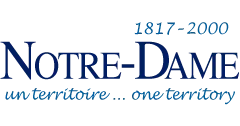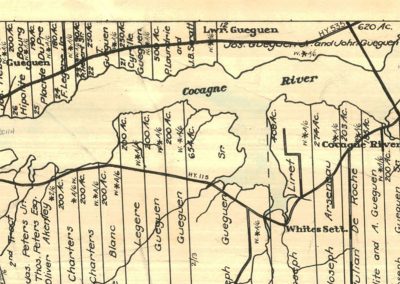Guéguen
The historical village of Guéguen dates to the early 1830’s. It is located on the North side of the Cocagne River at Notre-Dame, along Route 535, between Grub Road and Murray Road.
This was an industrious village with businesses, post office, school, and store. In the early days, houses between Robert Johnston and Mary Balser (corner of Grub Road) and John and Mary Cuthberston (Route 535) were considered to be part of Hays but today, this stretch is considered part of Guéguen.
Local author Généva Cormier Léger’s book, “Guéguen, mon village natal” details family genealogy and way of life for those who lived in this historical village. It was published in 2013 and is rich with details.
1800 to 1850
1826
Dundas was created from Wellington Parish, and it covered a large territory on the southern belt of Kent County. Communities such as Cocagne, Grande-Digue, Notre-Dame, Saint-Antoine, Goudalie, etc. were all part of the civil Parish of Dundas.
The Parish had a say in local governance and a responsibility to administer services such as schools. A local committee hired teachers, maintained the school infrastructure and grounds in good order, etc. As local schools were built, the district assigned them a number. For example, the district of Guéguen was designated as District Dundas 4.
early 1830s
Basile Goguen is believed to be the first settler in Guéguen. He was followed by Thomas Goguen, Hubert LeBlanc, and Raphaël Richard, all from Memramcook. As well, Aimé Langis (Rimouski) moved to Guéguen after two relatives came to teach at the Cocagne North River School or l’École de Guéguen.
1835
On April 11, 1835, David Cormier purchased land in Guéguen from Placide Dupré. Placide and his brother Gabriel settled in Guéguen.
1850
The province took charge of post offices and employees became salaried government workers. James Lucas was postmaster at the time, a way office in his home in Cocagne, also serving neighbouring communities.
1851 to 1875
1873
A post office opened in Guéguen with Magloire Guéguen as first postmaster. He served until 1890.
Note: The Guéguen Post Office was also referred to as Cocagne River PO. It was separate from the Lower Guéguen Post Office.
1875
A school was built in Guéguen and known as Cocagne River North, Parish of Dundas, NB. Its name would change again in 1911.
1876 to 1900
1879
The Cocagne River North School, which was built in 1875, opened in 1879. Located at the corner of Murray Road and Route 535, it served the children of the immediate area.
1885 to 1900
Lucas Goguen operated a windmill which produced shingles in Guéguen. Several area houses were made with these quality shingles. Goguen also built barrels for storing salted vegetables, fish, and meat. Later, he built himself a boat and then several large sail boats to fish. A wealthy man, he moved his family to Cocagne Island in 1900 and built a large home in 1916. He opened a lobster cannery, personally making the cans and employing up to twenty people. In 1948, his house was one of the last to cross the ‘bridge of ice on the bay’ and be moved to the mainland, across the Église Saint-Pierre church. Later, it was bought by the Church and sold to the congregation Notre-Dame-du-Sacré-Coeur who turned this large house into a convent. The Lucas Goguen home returned into the hands of the family and served as a B&B for many years. In 2004-2005, it housed youth from across Canada associated with the Katimavik Program.
1889
A territory was established for the new church, the parish was canonized, and the community welcomed its first priest, Père Honoré Ouellet, who stayed until 1897. Between 1889 and 1923, the parish of Notre-Dame served the neighbouring community of Saint-Antoine.
1894
On May 30, 1894, Philip Goguen exchanged $4.25 worth of potatoes and bought two sheep from Maximin Babineau for $2.50 as noted in a record of household affairs.
1895
On June 10, 1895, Maximin Babineau bought one pair of oxen for $40 as noted in a record of household affairs.
1896
In June 1896, Edward White hired several men to work: Fred Barnes, Thomas Scott, John Cochran, Silvain Goguen, Maxime Goguen, and Philip A. Goguen.
1897
On October 9, 1897, Ferdinand Léger bought 12m of shingles for $12 as noted in a record of household affairs.
1898
Guéguen was described as being a farming and lumbering settlement with one post office and a population of 150, including Lower Guéguen. The Guéguen Post Office operated between 1873 and 1952. The Lower Guéguen Post Office operated between 1911 and 1954.
1901 to 1925
1900
One-half ton of hay cost $3.50, one bushel grass seed $2.50, one pair of shoes $1.10, five locks and nobs $1.50, one bottle of Mother Seigel $0.30, one hundred lbs of flour $5, three lbs of tea $1.20, one gallon of oil $0.25, and one bottle of liniment $0.35 according to a record of household affairs.
1901
The Catholic Church was officially named Notre-Dame-du-Sacré-Coeur and the parish subsequently defined the territory of the community of Notre-Dame. The hamlets (or historical villages) included were MacDougall Settlement, Poirier Office, LeBlancville, Dufourville, Notre-Dame Centre, Guéguen, Hays, Alexandrina-Nor’ouest, North and South sides of the river, Whites Settlement along with Village des Pishcots, Village des Fricots, Suretteville, Teed Road and Chemin des Thaddées.
1903
The inspector, who visited the Cocagne River North School in Guéguen, found it unacceptable that lone teacher of eight grades, Hélène Bourque, had 82 students. He gave the district of Dundas an ultimatum to either expand or close the school. In 1911, its name changed to “École de Guéguen”.
1910 to 1925
David Richard of Guéguen built and operated a windmill to cut lumber. He also built caskets with the help of his son Tilmon.
1911
The Cocagne River North school located in Guéguen changed its name to École de Guéguen.
1911
A post office opened in Lower Guéguen and operated until 1954.
1925 to 1950
1932
A few people had electricity as early as 1932 and by 1940, service was widespread but did not reach every corner of the village. This proved to be a fatal blow to several hamlets and the main reason why these areas were eventually abandoned, such as Alexandrina-Nor’ouest, chemin des Thaddées, Village des Pishcots, Village des Fricots, and Suretteville.
1939
On November 12, 1939, Notre-Dame marks the 50th anniversary of the building of its Catholic Church. Mass was celebrated by parish priest Father Désiré Allain, Abbé Philippe Robichaud, (originally from Notre-Dame and serving the Shemogue Church), and Abbé Placide LeBlanc (Port-Felix, NS). During the evening activities, Kent Federal Deputy Alexandre Doucet (Notre-Dame Centre) and Ernest Langis (Guéguen) addressed the large crowd assembled at the parish hall.
1951 to 2000
1952
The post office in Guéguen closed.
1954 to 1956
A home postal delivery service was introduced in Notre-Dame. Mail was delivered by drivers who would insert letters and parcels in mailboxes next to the road of each house and business throughout the community. One route started at the Notre-Dame Post Office then onward to Hays, Alexandrina-Nor’ouest, across the covered bridges to Poirier Office, LeBlancville, Dufourville and ending where the route began, at the post office. Delivery areas grew to include Guéguen, the South side of the river road. The MacDougall Settlement mail delivery was and remains part of a different route.
With the arrival of mailboxes and home postal delivery, several small post offices were closed, such as Dufourville, LeBlancville, Alexandrina-Nor’ouest, Poirier Office, and MacDougall Settlement.
Postal delivery was first done and for many years by Joe Delaney, followed by Thomas Robichaud, M. Delaney, Olivier Bourque, Alcide Pellerin, Frank Maillet, Regis Bourque, and others.
About 1955
Ernest Langis opened a small store on the north side of the river and on the corner of Murray Road. This store was in operation until 1972.
1958
Notre-Dame was made up of 7 different school districts: Upper Guéguen, Hays, Alexandrina, LeBlancville, Dufourville, MacDougall Settlement and Notre-Dame. A few years back, the Whites Settlement district had joined Cocagne. The school board was responsible for school maintenance and repair as well as for the hiring of teachers, heating, and other expenses, paid for by local taxes.
1959
On January 14, 1959, the two-room wooden schoolhouse École de Dundas was destroyed by fire. Classes are held in the community hall and in the church basement. Ten short months later, a new two storey brick school was officially opened on November 14. L’École Centrale de Notre-Dame continues to cater to francophone students from the four corners of the community. Today, it is known as École Notre-Dame. First principle was Roméo Robichaud, followed by Gérald Aucoin who remained for many years.
early 1960
The school at Guéguen closed. Students attended l’École Centrale de Notre-Dame.
2000
In March, the postal addresses were changed from site and box number to civic numbers thereby improving efficiently and visibility, especially for emergency services such as fire and balance services.


